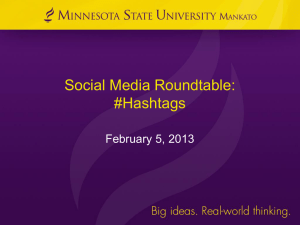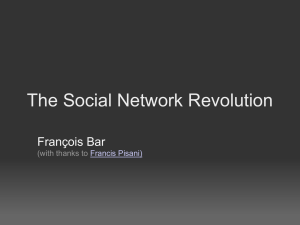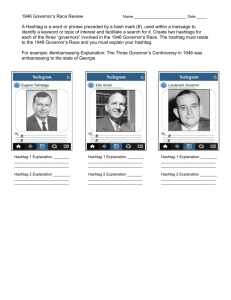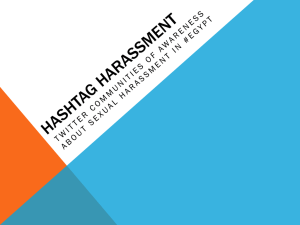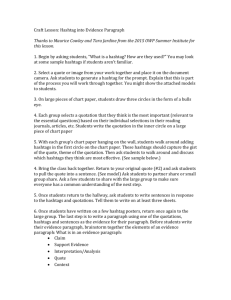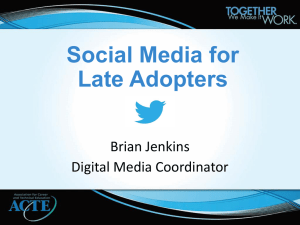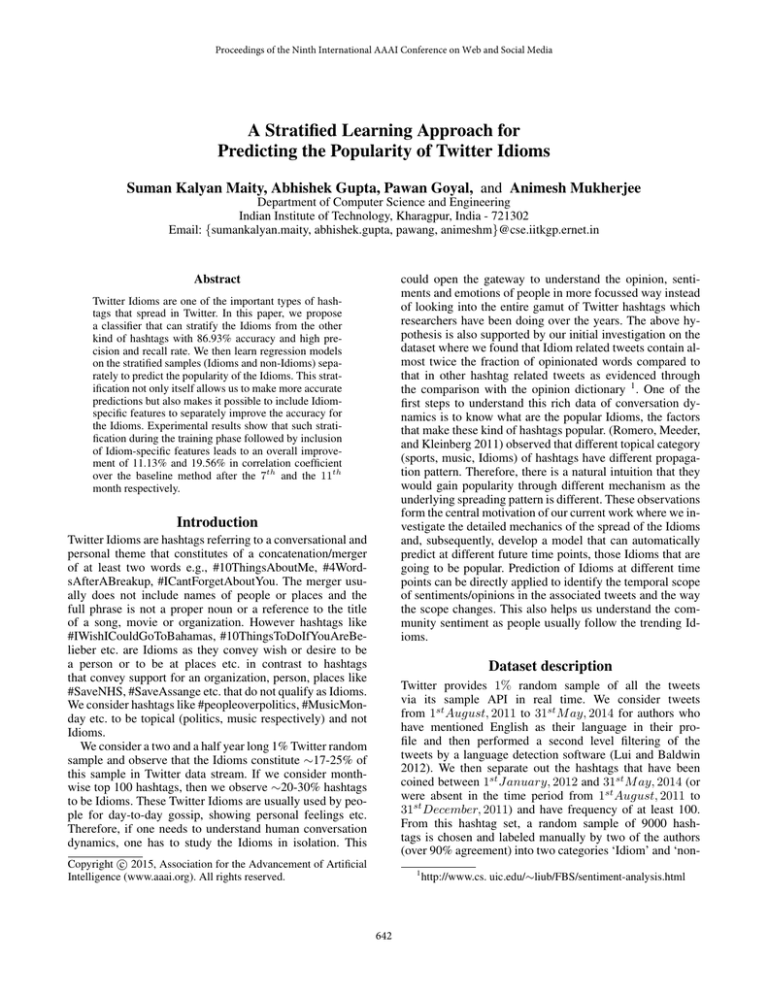
Proceedings of the Ninth International AAAI Conference on Web and Social Media
A Stratified Learning Approach for
Predicting the Popularity of Twitter Idioms
Suman Kalyan Maity, Abhishek Gupta, Pawan Goyal, and Animesh Mukherjee
Department of Computer Science and Engineering
Indian Institute of Technology, Kharagpur, India - 721302
Email: {sumankalyan.maity, abhishek.gupta, pawang, animeshm}@cse.iitkgp.ernet.in
Abstract
could open the gateway to understand the opinion, sentiments and emotions of people in more focussed way instead
of looking into the entire gamut of Twitter hashtags which
researchers have been doing over the years. The above hypothesis is also supported by our initial investigation on the
dataset where we found that Idiom related tweets contain almost twice the fraction of opinionated words compared to
that in other hashtag related tweets as evidenced through
the comparison with the opinion dictionary 1 . One of the
first steps to understand this rich data of conversation dynamics is to know what are the popular Idioms, the factors
that make these kind of hashtags popular. (Romero, Meeder,
and Kleinberg 2011) observed that different topical category
(sports, music, Idioms) of hashtags have different propagation pattern. Therefore, there is a natural intuition that they
would gain popularity through different mechanism as the
underlying spreading pattern is different. These observations
form the central motivation of our current work where we investigate the detailed mechanics of the spread of the Idioms
and, subsequently, develop a model that can automatically
predict at different future time points, those Idioms that are
going to be popular. Prediction of Idioms at different time
points can be directly applied to identify the temporal scope
of sentiments/opinions in the associated tweets and the way
the scope changes. This also helps us understand the community sentiment as people usually follow the trending Idioms.
Twitter Idioms are one of the important types of hashtags that spread in Twitter. In this paper, we propose
a classifier that can stratify the Idioms from the other
kind of hashtags with 86.93% accuracy and high precision and recall rate. We then learn regression models
on the stratified samples (Idioms and non-Idioms) separately to predict the popularity of the Idioms. This stratification not only itself allows us to make more accurate
predictions but also makes it possible to include Idiomspecific features to separately improve the accuracy for
the Idioms. Experimental results show that such stratification during the training phase followed by inclusion
of Idiom-specific features leads to an overall improvement of 11.13% and 19.56% in correlation coefficient
over the baseline method after the 7th and the 11th
month respectively.
Introduction
Twitter Idioms are hashtags referring to a conversational and
personal theme that constitutes of a concatenation/merger
of at least two words e.g., #10ThingsAboutMe, #4WordsAfterABreakup, #ICantForgetAboutYou. The merger usually does not include names of people or places and the
full phrase is not a proper noun or a reference to the title
of a song, movie or organization. However hashtags like
#IWishICouldGoToBahamas, #10ThingsToDoIfYouAreBelieber etc. are Idioms as they convey wish or desire to be
a person or to be at places etc. in contrast to hashtags
that convey support for an organization, person, places like
#SaveNHS, #SaveAssange etc. that do not qualify as Idioms.
We consider hashtags like #peopleoverpolitics, #MusicMonday etc. to be topical (politics, music respectively) and not
Idioms.
We consider a two and a half year long 1% Twitter random
sample and observe that the Idioms constitute ∼17-25% of
this sample in Twitter data stream. If we consider monthwise top 100 hashtags, then we observe ∼20-30% hashtags
to be Idioms. These Twitter Idioms are usually used by people for day-to-day gossip, showing personal feelings etc.
Therefore, if one needs to understand human conversation
dynamics, one has to study the Idioms in isolation. This
Dataset description
Twitter provides 1% random sample of all the tweets
via its sample API in real time. We consider tweets
from 1st August, 2011 to 31st M ay, 2014 for authors who
have mentioned English as their language in their profile and then performed a second level filtering of the
tweets by a language detection software (Lui and Baldwin
2012). We then separate out the hashtags that have been
coined between 1st January, 2012 and 31st M ay, 2014 (or
were absent in the time period from 1st August, 2011 to
31st December, 2011) and have frequency of at least 100.
From this hashtag set, a random sample of 9000 hashtags is chosen and labeled manually by two of the authors
(over 90% agreement) into two categories ‘Idiom’ and ‘non-
c 2015, Association for the Advancement of Artificial
Copyright Intelligence (www.aaai.org). All rights reserved.
1
642
http://www.cs. uic.edu/∼liub/FBS/sentiment-analysis.html
Idiom’. Out of these 9000 hashtags, 1575 hashtags are found
to be ‘Idioms’. In order to deal with the imbalance between
the two categories, we randomly choose 1575 non-Idioms
from the set of labeled non-Idioms. From this set of 3150
hashtags, we found some hashtags with 90% of their tweets
as the same retweet. We remove these hashtags and finally
we have 2931 hashtags. In Table 1, we show some example
hashtags from Idiom and non-Idiom categories.
These are:
Hashtag character length
Number of words in the hashtag
Avg. and maximum character length of the words in the
hashtag
Presence of days of the week and numerals in the
hashtag
Presence of constituent words of the hashtag in the
dictionary
Hashtag collocation
Parts-of-Speech tag diversity - We use CMU POS
tagger (Owoputi et al. 2013) for identifying the POS
tags after segmenting the hashtag. We consider 14
important POS tags as feature for our classification model. We define
the POS diversity (PosDiv) as
P
P osDiv(hi ) = − j∈posset pj × log(pj ) where hi is the
ith hashtag and pj is the probability of the j th POS in the
set of POS tags. We use this diversity metric as a feature for
our classifier.
Presence of common personal pronouns, verbs in the
hashtag
Presence of n-grams in English texts - We segment the
words in the hashtags and search for 2, 3, 4, 5 grams of the
constituent words in the corpus of 1 million contemporary
American English words2 . We use the presence of any of
these n-grams as a feature for the classifier.
Hashtag Clarity - Hashtag clarity as defined in (Ma, Sun,
and Cong 2012)
Word Diversity - If Hi is the document containing all the tweets in which hashtag i appears and
p(w|Hi ) is the probability of a word belonging to
the document HiPthen word diversity is defined as
W ordDiv(i) = − w∈Hi p(w|Hi ) × log p(w|Hi ).
Topical Diversity - We adopt Latent Dirichlet Allocation
(LDA) (Blei, Ng, and Jordan 2003), a renowned generative
probabilistic model for discovery of latent subtopics.
We set number of subtopics as K = 10, 20, 30 and find
out p(topick |Hi ) for a document Hi containing all the
tweets in which the ith hashtag appears and then compute the topical diversity (T opDiv) for ith hashtag as
PK
T opDiv(i) = k=1 p(topick |Hi ) × log p(topick |Hi ).
Cognitive Dimension - The cognitive dimension (linguistic
and psychological) for different kind of hashtags is captured
through the different categories provided by LIWC software (Pennebaker, Francis, and Booth 2001).
In-vocabulary words and Out-of-Vocabulary words
ratio in the tweets for a hashtag
Mention multiplicity - Fraction of tweets containing the
hashtags in which no mention, one mention, two mentions,
three or more mentions are used.
Retweet multiplicity - Fraction of times a tweet containing
the hashtag is retweeted multiple times. We have used 4
features corresponding to different retweet multiplicities (0,
1, 2, 3 or more).
Category Examples
Idioms
GuysBeLike,
TeenagersFact,
10ThingsIHateAboutMyself,
TuesdayTease,
Things90skidsSaid, WorstBreakupExcuse
nonSummerBall, TVDParty, SussexHour, GOTIdioms
Season4, Election2013, BelieveMovie
Table 1: Examples of Idioms and other type of hashtags.
Experimental Framework
Our goal is to predict the popularity of Idiom hashtag h at a
time period ∆t after its birth. We approach the problem in
two stages. In the first stage, we train a classifier with a set
of features (first level) to separate the test sample into Idiom
and non-Idiom category. We use Support Vector Machine
(SVM) and logistic regression for the classification. In the
next stage, we attempt to predict the popularity of the Idiom
class by learning a regression model with a set of specialized
features (second level) to predict the popularity (see fig 1).
The normalized count (Tsur and Rappoport 2012) which we
presume as a measure of popularity is defined as follows:
X
m0
N (hi ) =
count(hij ) ×
mj
j∈months
where count(hij )
i
th
is the number of appearances of the hashtag h in the j month. mj is the sample size of new hashtags that appear in month j. m0 is a constant whose value is
considered to be m1 , i.e., the sample size of these hashtags
in the 1st month. We use Support Vector Regression (SVR)
for predicting the log normalized counts.
Figure 1: (Color online) A schematic of our proposed framework.
Hashtag Classification
For the task of classification, we use three major types of
features - Hashtag content, Tweet content and User features.
2
643
http://www.ngrams.info/samples coca1.asp
Performance evaluation of the classifier
Word clarity in a hashtag Word clarity is a similar measure
to the hashtag clarity. It is formally defined as KL divergence of word distribution within the hashtag and global
word segment collection containing all the hashtags W ;
P
i)
W Clarityi = − w∈Di p(w|Di ) × log p(w|D
p(w|W ) where
w are the words within the word collection of the hashtag
(Di ), p(w|Di ) is the local probability of a word to be
present in the hashtag and p(w|W ) is the probability of
belongingness of a the word w in the segmented word pool.
Tweet content features These features are related to the
content of the tweet in which the hashtag appears.
Hashtag clarity Hashtag clarity is an important feature in
predicting user adoption of a hashtag (Ma, Sun, and Cong
2012).
Pagerank of the hashtags We constructed a co-occurrence
graph considering all the words and hashtags in the tweet
collection. An edge represents collocation in the same
tweet. The number of collocations serves as edge weight.
We prune out all such edges which have very small weight.
We then run Pagerank algorithm on this graph to obtain the
pagerank values of all the hashtags. This measure indicates
how “central” a hashtag is within the collection of tweets.
User features User’s tweeting behavior is also instrumental
in propagation of hashtags. Here, we describe user features.
Mention Multiplicity We measure fractions of tweets in
which no mention, one mention, two mentions and three or
more mentions are made. Higher the mention multiplicity,
higher is the chance that a hashtag will gain popularity.
Retweet Multiplicity Like mentions, we measure retweet
multiplicity as fraction of tweets in which no, one, two and
three or more retweets been made. We use these 4 attributes
as 4 different features.
Temporal features In the prediction of the popularity of
a hashtag, the early patterns of spread are important in
knowing how the hashtag will survive in long term. In
this subsection, we shall discuss some of these interesting
temporal features.
Early coinage The hashtags that are coined earlier have
higher chance to survive if there are potential competitors.
For example, #ThingsAboutMe has multiple variants
#10ThingsAboutMe, #20ThingsAboutMe etc. Similarly,
#FlashbackFriday has all other possible variants with other
days of the week. We ranked the hashtags according to their
time of birth and use normalized rank as a feature.
Exposure to different set of users In order to identify the
level of exposure of hashtags, we compute the fraction of
unique users who have tweeted using a hashtag in the first
50 tweets. This serves as a feature for our model. We also
find out number of unique users who have been mentioned
by someone in a tweet containing the hashtag and number
of users who have been exposed multiple times in the first
50 tweets as other two features.
Time gap between first few tweets We consider first few
tweets (41 tweets) for each hashtag. We then find out the
time difference between each of these tweets at leads of
1
5. We calculate percentage change in the time i.e, t6t−t
,
1
t11 −t6 t16 −t11
. . . . In summary, we have 8 such percentage
t6 ,
t11
change values as features.
We use SVM and logistic regression classifier available in
Weka Toolkit (Hall et al. 2009). We perform a 10-fold crossvalidation on the entire data and achieve 86.9% accuracy
with high precision and recall rates (see Table 2 for details). Both the classifiers yield very similar classification
performance. We observe that the number of topics of LDA
does not have significant effect on the classification results.
Therefore, for the second stage prediction we consider no. of
topics as 10 and train the SVM classifier on separate training set and test it on a separate test set. We choose a random
sample of 1000 hashtags as training set and another 1000
hashtags as test set. We achieve an accuracy of 86.1% on this
test sample. Hashtag content features (hashtag length, POS
tag diversity, n-gram presence, hashtag collocation etc.) are
the most discriminative ones followed by tweet features (especially the LIWC features).
Method
10fold
Cross
Validation
Classifier
SVM
Logistic
Regression
Separate SVM
training Logistic
and test Regresset
sion
K
10
20
30
10
20
30
10
10
Accuracy
86.9
86.25
86.49
86.76
86.49
86.46
86.1
86.01
Precision
0.868
0.863
0.865
0.868
0.865
0.865
0.861
0.86
Recall FScore
0.868 0.868
0.863 0.863
0.865 0.865
0.868 0.868
0.865 0.865
0.865 0.865
0.861 0.861
0.86 0.86
ROC
Area
0.868
0.862
0.865
0.939
0.938
0.938
0.862
0.933
Table 2: Performance of various classifier for different topic
selection for LDA feature with number of topics (K = 10,
20, 30).
Predicting the popularity of Twitter Idioms
In this section, we learn a regression model (SVR) to predict
the popularity of the classified Twitter Idiom hashtag set
by the SVM classifier within a given time frame ∆t. The
popularity of a hashtag within time window ∆t is defined
by log normalized count of the hashtag within the same time
window (Tsur and Rappoport 2012). We use the features
described in (Tsur and Rappoport 2012) as baseline features
for our model.
Idiom-specific features: We incorporate a set of new
features which are instrumental in popularity prediction for
Idioms. We categorize these features in four groups: hashtag
content features, tweet content features, user and temporal
features.
Hashtag content features These features are related to the
words that constitute the hashtag.
Presence of common verb and personal pronouns
Frequency of the n-grams in the English texts
Diversity of the POS tags of the words in the hashtag
Hashtag repetition For each hashtag, we calculate fraction
of tweets in which the hashtag appears multiple times.
We use this hashtag repetition ratio as a feature for our
regression model.
644
Time
frame
Performance of our regression model
For a regression task, the most significant evaluation metrics
are correlation coefficient (ρ) and root mean square error (θ).
In this paper, we predict the popularity value at two different
time instances (after 7 months and after 11 months). First,
we apply the baseline features to train the regression model
on 1000 training samples and test on a 1000 test sample. We
achieve a correlation coefficient and root mean square error
of 0.6058 and 0.7674 respectively. We then use our firststage classifier to stratify the test samples into Idioms and
non-Idioms. On this separated Idiom test set (∼ 500), we
use the baseline features using same sized training sample
of Idiom data selected from the corpus. This stratification
helps in improving the correlation coefficient (ρ) by 7.1%
and reducing the root mean square error (θ) by 6.36%. As
a subsequent step, we separately apply the Idiom specific
features on the same training and test data. Incorporating
these features boosts up the correlation coefficient by 3.76%,
and reduces the root mean square error by 2.25% (see table 3 for details). Overall, this stratification strategy helps
in improving correlation coefficient from 0.6058 to 0.6732,
i.e., by 11.13%. We also learn the regression model for predicting the popularity value at a longer time point (after 11
months). The improvement is relatively higher in comparison to the short range predictions3 . The stratification approach improves the correlation coefficient by 12.2% and
the incorporation of the Idiom specific features boosts it by
another 6.55% leading to an overall improvement of 19.56%
in correlation coefficient over the baseline method. We use
RELIEF F feature selection algorithm in Weka Toolkit to
rank the features. The rank order indicates that for popularity
prediction (at least in the early stages) usually the user and
the temporal features are more important than content features. For prediction at later time point, certain content features like hashtag clarity also gain significant importance.
This possibly points to the fact that as hashtags grow old,
their contents become an important determinant of their popularity.
ρ
Method
After
Baseline
7
Stratification
months Idiom
specific
features
After
Baseline
Stratification
11
months Idiom
specific
features
θ
% improvement
in ρ
% improvement
in θ
0.6058 0.7674
0.6488 0.7186 7.1
0.6732 0.7024 11.13
6.36
8.4
0.3932 0.7635
0.4412 0.7321 12.2
0.4701 0.7121 19.56
4.11
6.73
Table 3: Performance of the regression model. The % improvements are shown over the baseline.
the root mean square error increases to 0.7756 from 0.7674.
A possible reason for this phenomena is that the baseline
features are more suitable to the Idiom class compared to
the non-Idiom class. However, we would like to remark that
the type of hashtags belonging to this non-Idiom class are
mostly event-based, so their popularity indicators are different.
Acknowledgments
The authors would like to thank Prof. Chris Biemann, TU
Darmstadt for providing them with a historical Twitter 1%
random sample data. This work has been supported by Microsoft Corporation and Microsoft Research India under the
Microsoft India PhD fellowship Award.
References
Blei, D. M.; Ng, A. Y.; and Jordan, M. I. 2003. Latent dirichlet
allocation. J. Mach. Learn. Res. 3:993–1022.
Hall, M.; Frank, E.; Holmes, G.; Pfahringer, B.; Reutemann, P.; and
Witten, I. H. 2009. The weka data mining software: An update.
SIGKDD Explor. Newsl. 11(1):10–18.
Lui, M., and Baldwin, T. 2012. Langid.py: An off-the-shelf language identification tool. ACL ’12, 25–30.
Ma, Z.; Sun, A.; and Cong, G. 2012. Will this #hashtag be popular
tomorrow? SIGIR ’12, 1173–1174. New York, NY, USA: ACM.
Owoputi, O.; Dyer, C.; Gimpel, K.; Schneider, N.; and Smith, N. A.
2013. Improved part-of-speech tagging for online conversational
text with word clusters. NAACL ’13.
Pennebaker, J. W.; Francis, M. E.; and Booth, R. J. 2001. Linguistic Inquiry and Word Count. Mahwah, NJ: Lawerence Erlbaum
Associates.
Romero, D. M.; Meeder, B.; and Kleinberg, J. 2011. Differences
in the mechanics of information diffusion across topics: Idioms,
political hashtags, and complex contagion on twitter. WWW ’11,
695–704. New York, NY, USA: ACM.
Tsur, O., and Rappoport, A. 2012. What’s in a hashtag?: Content
based prediction of the spread of ideas in microblogging communities. WSDM ’12, 643–652. New York, NY, USA: ACM.
Conclusions
In this paper, we have adopted a two-stage framework for
predicting popularity of Twitter Idiom hashtags at different
time intervals after the birth of the hashtags. We developed
a binary classifier incorporating a wide variety of features to
stratify the hashtag set into disjoint Idiom and non-Idiom set.
The classifier achieves 86.9% accuracy with a high precision
and recall rate. We observe that the hashtag content features
have the most discriminative power compared to the other
types of features.
In the first stage of stratification, if one applies the baseline method on the stratified non-Idiom set, the correlation
coefficient decreases. For predicting the popularity after 7th
month, we observe that on the stratified non-Idiom set, the
correlation coefficient decreases from 0.6058 to 0.5917 and
3
We also did experiments on a much shorter range (predicting
at 10th week after observing 6 weeks data), where also we achieve
improvement over the baseline; however, the improvement is relatively less due to scarcity of data per hashtag on weekly basis.
645

